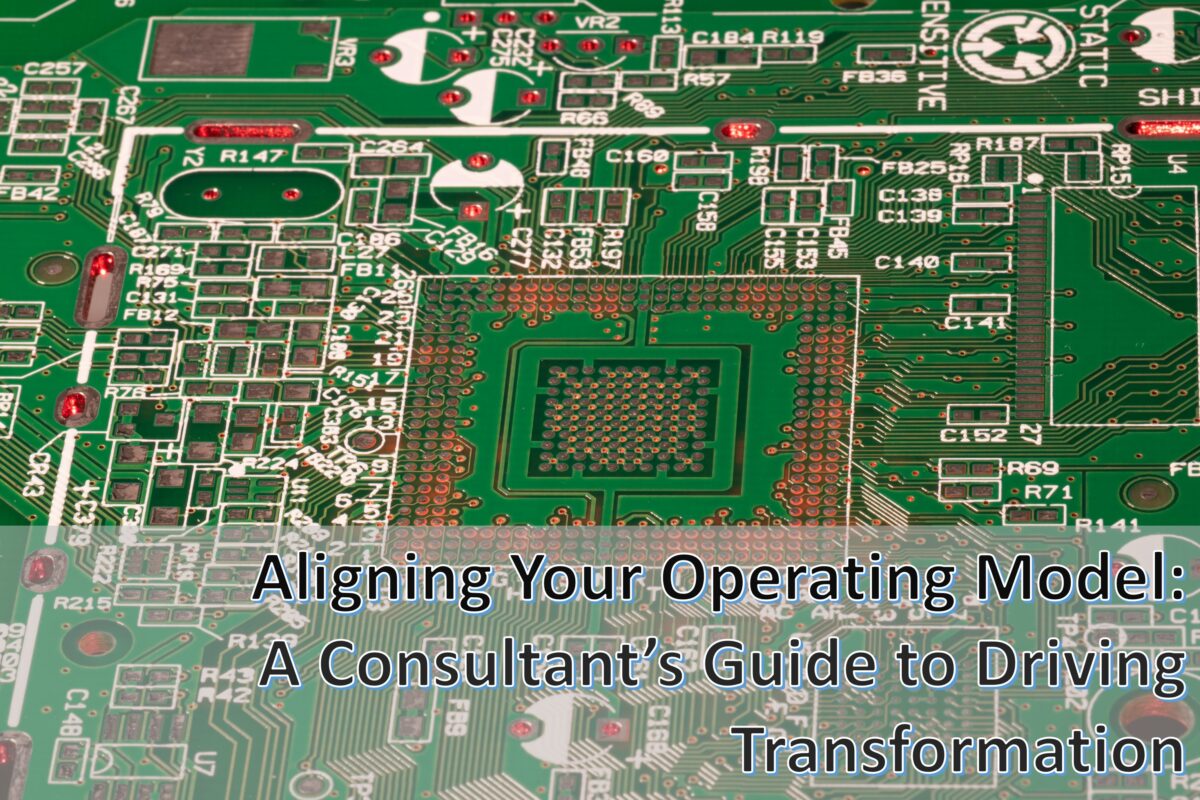An effective Target Operating Model (TOM) is more than a blueprint—it’s the glue that binds strategy to execution. To unlock its full potential, seven key components must not only be designed well in isolation but also aligned seamlessly with one another:
- Organizational Structure
- People (Headcount & Capabilities)
- Geographical Footprint
- Roles & Responsibilities
- Collaboration Models & Processes
- Governance (Decision Forums & Escalation)
- Corporate Culture
Below, I’ll describe how to align these building blocks—and how, as a consultant, I guide organizations through this journey—culminating in the clear benefits you can expect.
1. Start with the End in Mind: Strategy-to-Structure
Before any layer of your TOM can take shape, you must translate strategic objectives into structural imperatives:
- Define Strategic Priorities (e.g. growth markets, cost leadership, product innovation)
- Map Organizational Layers to those priorities (e.g. global business units, regional hubs, shared services)
A consultant’s role: facilitate executive workshops to crystallize strategy, then design a high-level org chart that embeds those priorities at every level.
2. People & Capabilities: Right Skills, Right Place
Once the structure is clear, identify the critical roles and capabilities needed:
- Headcount Planning: Quantify talent needs by function and geography
- Capability Assessment: Benchmark existing skills against future requirements
- Talent Roadmap: Hire, train, or redeploy people to close gaps
A consultant’s role: run capability assessments, lead skill-gap analyses, and co-create a talent-development plan with HR and business leaders.
3. Geographical Footprint: Local versus Global
Your footprint should align with your structure and people strategy:
- Centralized vs. Decentralized: Decide which functions (e.g. R&D, customer support) live in regional hubs versus centralized centers
- Regulatory & Market Factors: Evaluate tax, labor, and customer proximity considerations
A consultant’s role: model alternative footprint scenarios—balancing cost, compliance, and responsiveness—and recommend the optimal deployment of your teams.
4. Roles & Responsibilities: Who Does What, When
Clarity here prevents duplication and confusion:
- RACI Matrices: Document who is Responsible, Accountable, Consulted, and Informed for key processes
- Role Profiles: Define the decision rights, inputs, and outputs for each core role
A consultant’s role: facilitate cross-functional workshops to build RACI matrices, ensure both leadership and execution layers buy in, and lock down clear role descriptions.
5. Collaboration Models & Processes: The How of Getting Things Done
Processes are the nervous system of your TOM:
- Process Workflows: Map end-to-end processes, from order intake to delivery and billing
- Collaboration Platforms: Select tools (e.g. Teams, Miro, ERP) that embed your workflows
A consultant’s role: lead process-mapping sessions, introduce “best practice” process models, and ensure your chosen collaboration tools are configured to support them.
6. Governance: Decision Rights & Escalation Paths
Good governance balances speed and control:
- Decision Forums: Define which councils or committees make which decisions, at what frequency
- Escalation Models: Clarify how and when issues move up the chain
A consultant’s role: draft charters for governance bodies, recommend meeting cadences, and build dashboards that surface the right metrics to each forum.
7. Corporate Culture: The Invisible Catalyst
Culture ties it all together—without it, even the best-designed TOM will stall:
- Behavioral Principles: Articulate values that guide day-to-day actions (e.g. “Collaborate openly,” “Own the outcome”)
- Change Management: Use communications, role modeling, and quick-win celebrations to embed new ways of working
A consultant’s role: design a culture-activation plan—ranging from leadership alignment sessions to interactive town halls—that brings your values and behaviors to life.
Bringing It All Together: The Consultant’s Playbook
- Diagnosis & Baseline: Assess current TOM against desired future state
- Blueprint Design: Co-create alignment across all seven components
- Implementation Roadmap: Develop a sequenced plan with clear milestones, owners, and governance
- Execution Support: Embed a “train-the-trainer” approach, interim PMO support, and regular health-checks
- Sustain & Evolve: Establish continuous improvement cycles to keep your TOM fit for purpose
Key Benefits of a Holistic TOM Alignment
- Strategic Agility: Rapid pivoting in response to market shifts
- Operational Efficiency: Elimination of redundancies and process bottlenecks
- Enhanced Decision-Making: Faster, more transparent governance
- People Engagement: Clear career paths and ownership cultivate commitment
- Risk Mitigation: Robust processes and escalation paths reduce surprises
A fully aligned Operating Model doesn’t just exist on paper—it drives real, sustainable performance improvements. If you’re ready to give your transformation the backbone it needs, let’s connect and discuss how to tailor this approach to your organization.
